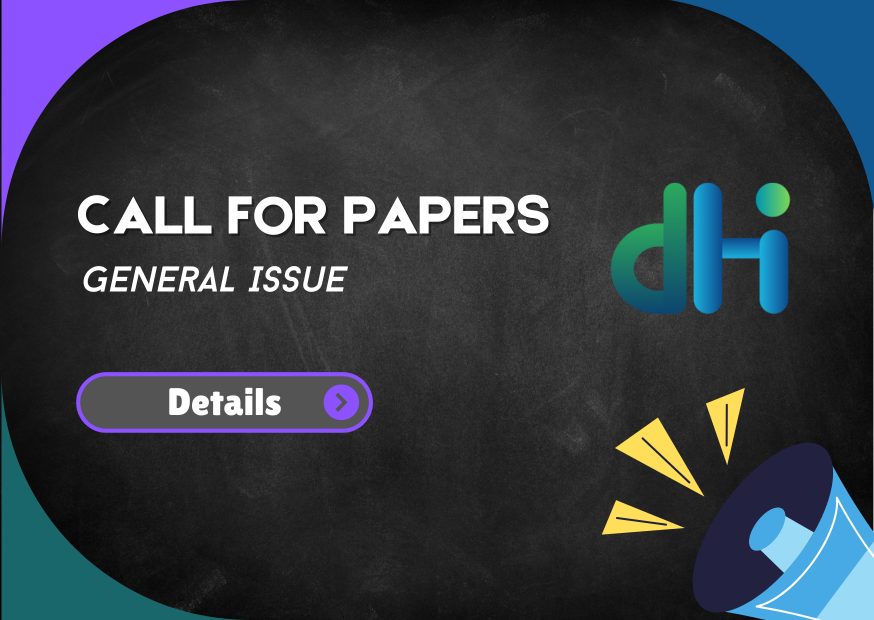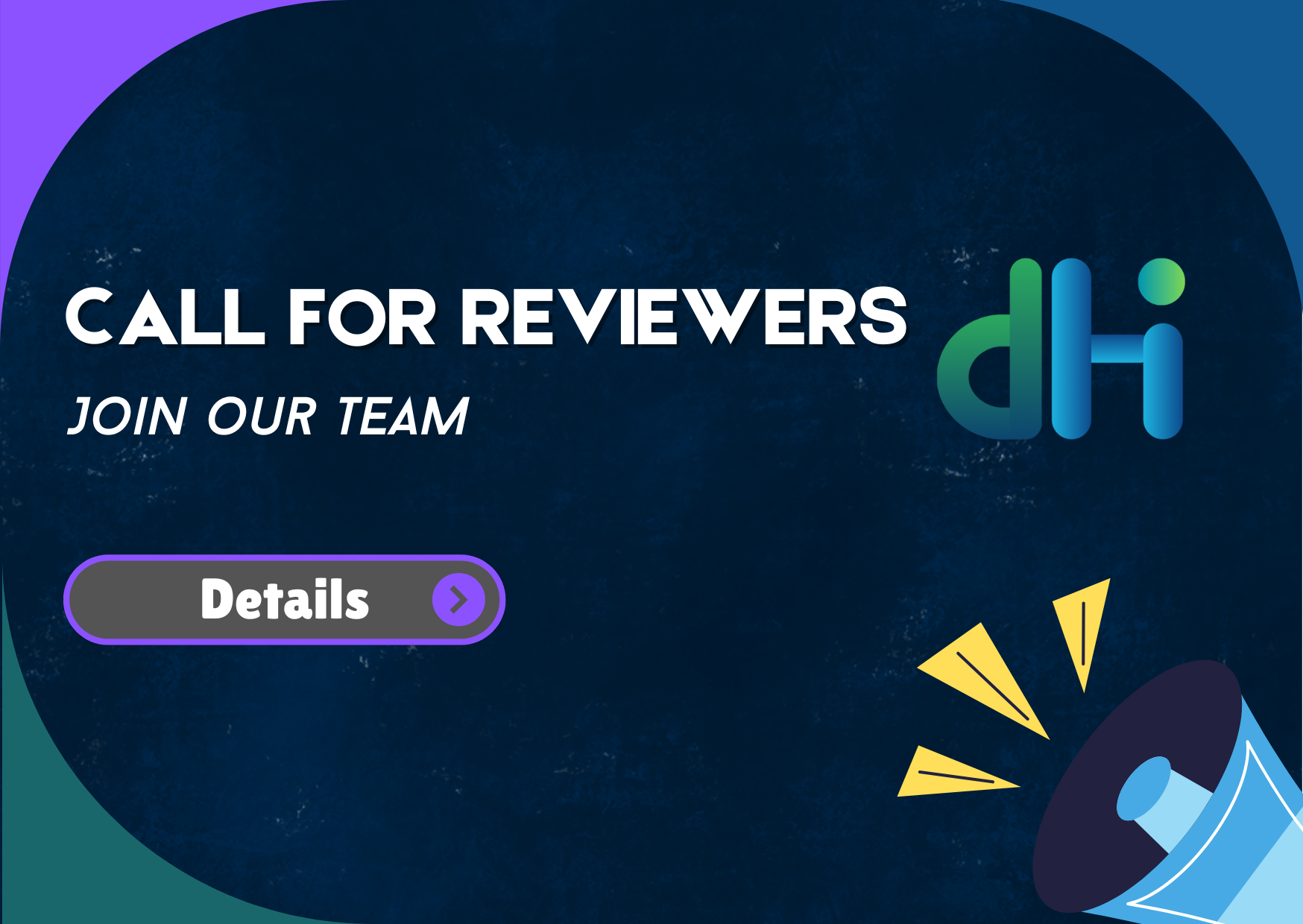Author Guidelines
Contents
- Submission Categories
- Online Submission
- Manuscript Preparation
- Cover Letter
- Supplementary Materials
- Revisions
- Proofs
Submission of a manuscript to Digital Humanities Intersections (DHI) implies that it contains original, unpublished material and is not under consideration for publication elsewhere. Authors are responsible for ensuring the integrity of their work through proper attribution of sources, and adherence to ethical research practices. Submissions should align with the journal’s thematic and methodological scope, engaging critically with digital humanities scholarship. To maintain academic rigor and accessibility, all manuscripts must follow the journal’s formatting, citation, and stylistic guidelines. We encourage authors to review the following guidelines carefully before submission.
Submission Categories
Digital Humanities Intersections (DHI) welcomes submissions in the following categories:
1. Articles
Original research contributions that present a clear research question, methodology, and findings, engaging with existing scholarship to propose significant theoretical, empirical, or methodological insights.
2. Reviews
Critical assessments of books, digital tools, software, projects, exhibitions, conferences, or other works relevant to digital humanities. Reviews should go beyond summaries, critically situating the work within broader scholarly debates and evaluating its contributions to the field.
3. Methods Papers
In-depth discussions of tools, workflows, software, or computational methods relevant to digital humanities. Method Papers should provide detailed accounts of their development, implementation, and applications along with a critical evaluation of their effectiveness, limitations and broader implications for the field.
4. Case Studies
Provide critical analysis of specific DH projects, highlighting their applications of established methods, tools or frameworks.
5. Theoretical and Conceptual Essays
Essays engaging with epistemology and ontology of digital humanities.
Online Submission
To access the online submission portal, you will need a User ID and Password. If you are unsure whether you already have an account or have forgotten your password, you can enter your email address in the Password Help section on the login screen. If you do not have an account, select the Create Account option at the login page and follow the instructions. For account issues, please contact the Editor rather than creating a new account.
Ensure that all submissions are made using the corresponding author’s account. Submissions should not be made through co-authors’ or third parties’ accounts.
All submission-related correspondence, including acknowledgments and editorial decisions, will be sent through email to the corresponding author.
Manuscript Preparation
Authors submitting to Digital Humanities Intersections (DHI) must ensure that their manuscripts adhere to the journal’s formatting and structural guidelines. This section outlines key requirements, including submission length, file format, document structure, and citation practices.
-
Length of a Submission
The word limits for each submission category are as follows: Articles (up to 8,000 words), Reviews, Methods Papers, and Case Studies (up to 5,000 words), and Theoretical/Conceptual Essays (up to 3,000 words). Submissions may be shorter than these limits depending on the nature of the contribution.
-
File Format
Manuscripts should be submitted in Microsoft Word format (.doc or .docx) to ensure compatibility with the editorial and peer review systems.
-
General Document Formatting
- Use Times New Roman, 12-point, as the standard typeface for clarity and accessibility.
- Double-space all text, including quotations and references, to facilitate readability and annotation.
- Set margins to at least 1 inch (2.54 cm) on all sides.
- Indent the first line of each paragraph by 0.5 inches (1.27 cm) using automatic indentation. Block quotations should be indented 0.5 inches from the left without quotation marks.
- Left-align the main text and avoid full justification for even word spacing and improved legibility.
-
The Title Page
The title page should clearly present essential information about the manuscript and its authors. It must include:
- The manuscript title, centered and in bold (title case), concise and descriptive (no more than 20 words).
- Authors’ names in order of contribution, each followed by a superscript number; corresponding affiliations (department, institution, city, country) listed separately.
Example:
Ananya P.1, Rohan M.2, Meera N.1
1 Department of History, IIT Delhi, New Delhi, India
2 Department of Digital Humanities, Ashoka University, Sonipat, India -
Abstract
The abstract should be between 200 and 250 words, summarizing the research objectives, methodology, key findings, and conclusions. It must be unstructured, without subheadings and avoid references, citations, footnotes, and unexplained abbreviations. Graphical abstracts are not supported; all abstracts must be text-based.
-
Keywords
Provide 4 to 6 relevant keywords that reflect the main themes, concepts, and methodologies of your study. Separate these keywords with commas, ensuring they are precise and searchable to enhance the discoverability of the article.
Headings and Subheadings
DHI uses a numbered hierarchical structure for headings and subheadings. The recommended format is as follows:
- Level 1: 1. Main Section Title (Bold, Headline-Style Capitalization)
- Level 2: 1.1. Subsection Title (Regular, Headline-Style Capitalization)
- Level 3: 1.1.1. Sub-subsection Title (Italicized or Bold, Headline-Style Capitalization)
- Level 4: 1.1.1.1. Lower-Level Subsection (Regular, Sentence-Style Capitalization)
Headings should not end with a period, and capitalization should follow the appropriate style for each level. Utilize Word’s built-in heading styles or proper style tagging for accessibility.
-
Images and Tables
All images and tables should be uploaded separately in a compressed (ZIP) folder during submission. Images must be in high-resolution (TIFF, PNG, or JPEG) and tables should be in an editable format (DOCX, XLSX), referenced within the manuscript (e.g., Figure 1 or Table 2) with a clear caption. Ensure legibility, proper organization and obtain necessary permissions for third-party materials.
-
Citations and References
DHI follows the Chicago Manual of Style (Author-Date) for all citations and references. Each cited work must be fully referenced in the bibliography with details such as the author, publication year, title, and publication information. Include DOIs or URLs when available to facilitate access. For detailed formatting instructions, refer to the Citation and Reference Guidelines.
-
Acknowledgements
Keep acknowledgements concise and professional. Do not include anonymous reviewers or editors. Recognize funding sources with grant numbers and any significant assistance in research, data collection, manuscript preparation, or technical support.
-
Statements
Include the following statements in your manuscript before the bibliography:
-
1. Author Contributions Statements
Detail individual author contributions using the Contributor Roles Taxonomy (CRediT) framework or a similar model. This may include, but is not limited to:
- Conceptualization – Developing the research idea and framework
- Methodology – Designing research methods and analytical approach
- Software – Developing or using digital tools and computational techniques
- Validation – Ensuring the accuracy and reliability of data or models
- Formal Analysis – Conducting qualitative or quantitative analysis
- Investigation – Performing research and data collection
- Resources – Acquiring datasets or archival sources
- Data Curation – Organizing research data
- Writing – Original Draft or Producing the initial manuscript
- Writing – Review and Editing or Revising for clarity and coherence
- Visualization – Creating figures or charts
- Supervision – Guiding the research team
- Project Administration – Managing project timelines
- Funding Acquisition – Securing financial support
"Author A and Author B contributed equally to the conceptualization and methodology. Author C conducted the formal analysis and wrote the initial draft. Author D supervised the research and secured funding. All authors reviewed and approved the final manuscript."
-
2. Competing Interests Statement
Include a competing interests statement. If none exist, state explicitly that the authors have no competing interests. Otherwise, describe any financial, professional, or personal relationships that might influence the research.
-
3. Data Availability Statement
Authors should include a statement specifying where the data supporting their study can be accessed. If data cannot be shared due to restrictions, clearly state the reasons when,
- Openly available: "The data supporting this study are available in [repository] at [DOI or URL]."
- Restricted access: "The data are available upon reasonable request."
- No new data: "This study did not generate new data; all analyzed data are publicly available."
-
4. Ethics Declaration
If your research involves human participants, personal data, or animals, include a statement confirming adherence to ethical guidelines and approval details (if applicable). If no ethical approval was needed, state this explicitly.
-
Cover Letter
Draft a concise, one-page (or under 400 words) cover letter addressed to the Editor-in-Chief. In your letter, briefly introduce your work, emphasize its significance, and explain how your manuscript aligns with the journal’s scope.
Supplementary Materials
If your manuscript includes supplementary materials (e.g., datasets, multimedia files, additional documents), submit them along with the main document. Clearly label each file and provide descriptive information within the manuscript. Ensure you have the necessary permissions for any third-party content.
Revisions
If revisions are required, you will receive detailed feedback from the editorial team. Address each comment systematically and include a response letter detailing the revisions made or reasons for not implementing specific changes. Resubmit the revised manuscript within the stipulated timeframe, following the journal’s formatting guidelines.
Proofs
After acceptance, you will receive page proofs for final review. Check carefully for typographical errors, formatting issues, or discrepancies, and approve corrections promptly to avoid publication delays. No further changes can be made once the proofs are approved.



